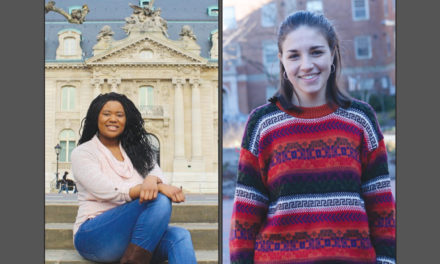Anahzsa Jones | Managing Editor
When Dr. Jamila Simpson, Assistant Dean for Diversity and Student Services for the College of Sciences, met her husband, she knew they were meant to be. His name, Clarence, is a family name. She told him, “We must be meant to be friends.”
For a year they were. She learned a lot that made her believe they would work well together in the future. “When you’re friends, because you’re not trying to impress each other, you can see how they talk about other people, how they think about things,” she said.
The more Dr. Simpson learned about Clarence, the more impressed she was. He skipped two grades, didn’t smoke or drink, played guitar for his church, and spent spring break volunteering with Habitat for Humanity. Even more impressive was his wide-ranging taste in music and people. She said, “He was living the diversity that I felt was so important.”
One way he stood out was by noticing how she said her name and how others did. She said, “He asked if my name was ‘juh-milla’ or ‘juh-meela’, and when I told him [it’s juh-meela] he said, ‘well then you should have people call you Jamila.’”
It may seem like a courtesy, but for Simpson it was much more. She said, “It was the first time that I had had someone affirm my name, and it sounds ridiculous, but it’s true…He was trying to instill in me a self confidence that I did not have. And I respected him so much for that.”
Simpson’s parents were adamant that she honored African Americans’ contributions to the country. Clarence, on the other hand, was not raised alongside issues of race. His father, who passed away when Clarence was 15, was a member of the U.S. Military and met his mother in the Philippines. Simpson says Clarence’s mother believed she had to assimilate, and so didn’t teach him much of her native heritage.
According to Simpson, “He didn’t come from a family that thought talking about race was important.” So she was surprised by the effort he made to further his understanding when offered the chance.
In her time at NC State, Simpson served as president of the Society of African American Physical and Mathematical Scientists (now the Society of Multicultural Scientists), the Afrikan American Student Advisory Council, and the Association for the Concerns of African American Graduate Students. “He knew what he was getting into,” Simpson said. Through their entire relationship, Clarence took an active interest in her loves.
He asked her once, “How could I learn more?” and she mentioned the iconic movie series “Roots.” That weekend he rented the entire series and they watched it together. “That’s when I knew he was serious about learning.”
His willingness to learn was a factor in Simpson’s decision to move their friendship to the next step. “I was projecting into the future,” she said. “I was not one of those people that saw dating as just having fun. I saw dating as finding out whether we’re compatible to possibly one day be married.
“For me and my social justice heart, that was important in a partner,” she continued. “I’m not going to hold it against you that you haven’t lived my experience, but you have to care about it.”
The couple dated for four and a half years. Simpson admits she questioned the relationship due to their races. “You do feel a responsibility to the black community. Here I am, president of this black organization and this one and this one… What am I communicating?” she said.
The largest hurdle in their relationship was Clarence’s mother. Dr. Simpson first met Mrs. Simpson when she and Clarence were friends. “She was very kind to me, to my face,” she said.
When they began dating, things changed. Simpson recalls a time when Clarence’s mother called him to say “I can’t believe you’re dating that black girl.”
There were those, namely Simpson’s father, that were afraid his mother’s feelings would keep them apart. Those fears, however, proved unfounded. “The proposal was pretty epic, I’m not going to lie,” Simpson said.
One day after work, Clarence took her to a “balloon rally” in Raleigh. When they arrived, it wasn’t balloons, but a billboard waiting for her. The message read: “Dear Shida, I know this has been a long time coming, but there’s an even longer time to look forward to. Will you marry me? Love, Clarence.”
The two were engaged and married in August 2002, but it wasn’t without hardship. Clarence’s mother’s opposition remained. Simpson confesses she was uncertain at times, that there was a lot of prayer involved, but eventually their decision was made.
“Me and Clarence basically had this point where we had to decide, are we going to live life without each other just because of how she feels or are we going to give this a chance? Are we going to allow hate to win over love? That’s what it came down to,” she said.
In the end, Clarence’s family didn’t come to the wedding. Simpson made a point to have her family and friends sit wherever they wanted. “What I didn’t want was for him to feel like he had nobody there to support him,” she said. “This is where friends are really important. To step up and be that family that he doesn’t have.”
Despite the groom’s lack of familial support, the wedding was a success. “It was great because it was really just about friends and family and really relaxed and laid back. He and I are both really nerdy, so it was really calm.”
The Simpsons have since had two sons and are teaching them to love themselves for who they are, melanin and all. “One thing I’m consistently working on is affirming their black heritage,” Simpson said, “And that’s not to dismiss the Filipino or the white side, but those aren’t under constant attack from society.”
Having mixed race children has not presented too many difficulties for Dr. Simpson, other than being mistaken for a nanny, having her son checked off as Hispanic at school, and being told she cannot film other people’s children in the hospital. But she’s taken it all in stride, thankful to live where her family can be themselves without fear.
Simpson says, “Overall it’s been great, because the Wake County area is more open-minded and inclusive.” She is glad to see her children benefit from this inclusivity. Having interracial parents and being exposed to different cultures has already put her eldest son ahead of the curve. Dr. Simpson, who teaches a diversity course at NC State, decided to try a version of “The Doll test” with him.
In the test, children are asked questions such as “Which doll is ugly? Which doll is pretty? Which doll is well behaved?” In both the 1947 and 2010 versions, most children of all ages and ethnicities identified the white doll with positive traits and the black one with negative traits. In 1947 only 38% of the children identified the black doll as having a “nice color.”
To her delight, her son did not follow the trend. His way of answering was to make up stories to justify why he chose each picture. The concept of one race being better than another, of racism, did not exist for him.
Clarence’s mother has yet to come around, so she is not a part of their lives. She was given chances: once when their eldest son was an infant, sick in the hospital. They called hoping for support and sympathy, but her response was “I told you not to have kids with that woman.” And that was that.
“Some people’s hate is so deeply rooted it’s not going to change and it is not your responsibility to change it,” Simpson said.
Their son recently asked about his grandmother and why she wasn’t around. Simpson explained the situation, “But also let him know that that’s not my problem, or his daddy’s problem. That’s her issue. I am determined that he will never see his blackness as a deficit.”
With this mission, Dr. Simpson could not have chosen a better partner, despite their races. “You also have to make sure that the psyche of who you’re with is supportive of your identity. There are some brown people who don’t necessarily align with the empowerment of brown people.”
Clarence might not be her shade of brown, but he is empowering. Dr. Simpson is active in her job, and she is able to do so due to his support. “He is why I am able to do the work that I do. He is not black, but he gets my job, and he loves my job. He is always looking for ways to help me.”
Dr. Jamila Simpson and her husband Clarence may not be the most traditional example of black love, but their family shows it in many ways. Love for one’s black self, black children and the black community are all encompassed, and that is why their story is worth telling.





